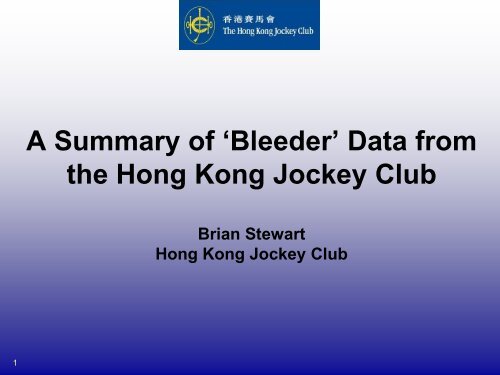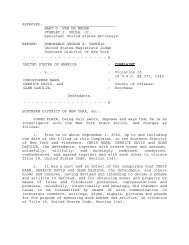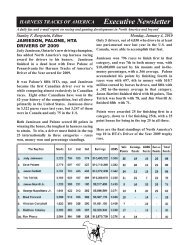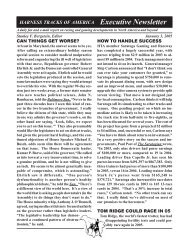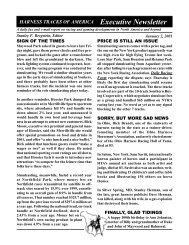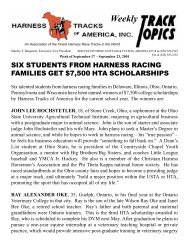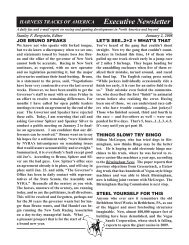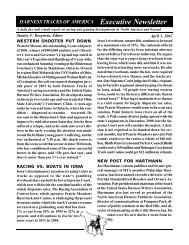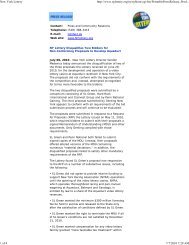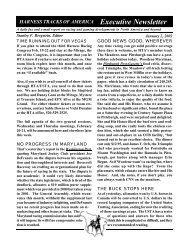'Bleeder' Data from the Hong Kong Jockey Club â Brian Stewart ...
'Bleeder' Data from the Hong Kong Jockey Club â Brian Stewart ...
'Bleeder' Data from the Hong Kong Jockey Club â Brian Stewart ...
Create successful ePaper yourself
Turn your PDF publications into a flip-book with our unique Google optimized e-Paper software.
A Summary of ‘Bleeder’ <strong>Data</strong> <strong>from</strong><br />
<strong>the</strong> <strong>Hong</strong> <strong>Kong</strong> <strong>Jockey</strong> <strong>Club</strong><br />
<strong>Brian</strong> <strong>Stewart</strong><br />
<strong>Hong</strong> <strong>Kong</strong> <strong>Jockey</strong> <strong>Club</strong><br />
1
Why <strong>Hong</strong> <strong>Kong</strong> Statistics?<br />
• Closed, highly regulated racing population.<br />
• Very high level of veterinary regulatory<br />
scrutiny and compulsory reporting.<br />
• Enthusiastic, well informed, passionate<br />
and demanding customers.<br />
• Comprehensive and thorough veterinary<br />
incident data collection.<br />
• The ideal ‘Racetrack Laboratory’<br />
2
Post-Race Regulatory Veterinary<br />
Examinations.<br />
• Horses that perform below expectations or<br />
that show signs that something may be<br />
amiss in running are sent for regulatory<br />
veterinary examinations performed<br />
immediately after <strong>the</strong> race and repeated<br />
on <strong>the</strong> morning of <strong>the</strong> day after racing.<br />
• Inspection / Auscultation / Endoscopic<br />
exam (post-race only) and trot up.<br />
3
Post-Race Regulatory Veterinary<br />
Inspections.<br />
• Performed on about ~10% of runners at<br />
request of <strong>the</strong> Stipendiary Stewards.<br />
• Positive findings in ~20% of inspected<br />
horses (~2.3% of all runners).<br />
4
EIPHS, ‘Bleeders’ and ‘Blood on<br />
Scoping’<br />
1. Substantial Quantity of Blood in <strong>the</strong><br />
Trachea (~official blood on scoping)<br />
‣ The presence of Grade 3 or Grade 4 blood<br />
in upper respiratory tract of a horse<br />
examined after racing at <strong>the</strong> request of <strong>the</strong><br />
Stipendiary Steward because of substandard<br />
racing performance.<br />
2. Official Bleeder (“Bleeder”)<br />
‣ Any quantity of blood of pulmonary origin at<br />
<strong>the</strong> nostrils after exercise.<br />
5
Causes of Disappointing Racing<br />
Performances<br />
• EIPHS (‘3+/4+ blood on Scope within 5 minutes of racing) ~ 30%<br />
• Bleeder ~ 8%<br />
But 59% of ‘Bleeders’ performed up to expectations.<br />
• Irregular Heart Rhythm ~ 12%<br />
• Lameness ~ 25%<br />
EIPHS is an important cause of<br />
disappointing racing performances.<br />
6
‘Official Bleeders’ (Epistaxis)<br />
(Horses with any quantity of blood of pulmonary origin<br />
at <strong>the</strong> nostrils after racing)<br />
Av. ~ 42 incidents per season<br />
~4.6 per 1000 runners<br />
Average for 2005/06 to 2010/11 season<br />
7
HKJC Regulation of ‘Official<br />
Bleeding’<br />
• 1 st Incident: 3 month ban <strong>from</strong> racing.<br />
• 2 nd Incident: Regulatory Assessment:<br />
Compulsory retirement or 3 month ban<br />
<strong>from</strong> racing.<br />
• 3 rd Incident: Compulsory Retirement<br />
8
Incidence of Post-Race Epistaxis<br />
• <strong>Hong</strong> <strong>Kong</strong> 4.7 / 1000 runners<br />
• Singapore 5.1 / 1000 runners<br />
• Victoria 1.5 / 1000 runners<br />
• NSW 2.0 / 1000 runners<br />
• UK (Flat) 1.3 / 1000 runners<br />
• N. America (a) (Pre-Lasix) 2.0 / 1000 runners<br />
• N. America (a) (Lasix) 0.6 / 1000 runners<br />
• N. America (b) (Lasix) 0.7 / 1000 runners<br />
• N. America (c) (Lasix) 0.7 / 1000 runners<br />
• N. America (d) (Lasix 1.15 / 1000 runners<br />
• N. America (e) (Lasix) 0.12 / 1000 runners<br />
9
The <strong>Hong</strong> <strong>Kong</strong> Environment<br />
• Compulsory reporting of ‘Bleeding’.<br />
• Very high level of regulatory scrutiny.<br />
• Very hot, humid Summers / cold, dry Winters.<br />
• Sudden and dramatic wea<strong>the</strong>r changes.<br />
• Air-conditioned stables.<br />
• Severe air pollution.<br />
‣ A very unfriendly environment for <strong>the</strong><br />
respiratory tract.<br />
10
The Costs of Bleeding.<br />
• Compulsory Retirements.<br />
• Sub-Standard Racing Performances /<br />
Inconsistent Performances.<br />
• Compulsory Down-Time.<br />
• Welfare Concerns / Perceptions<br />
11
Horse Retirements: Official Bleeders and<br />
Chronic EIPHS on Scope<br />
• Compulsory Bleeder Retirements<br />
‣ Av. 13 horses per year (3.8% of total<br />
retirements / 0.9% of total population)<br />
• Voluntary Bleeder and Chronic EIPHS<br />
Retirements<br />
‣ Av. 22 horses per year (6.5% of total<br />
retirements)<br />
Average for 2005/06 to 2010/11 season<br />
12
Return to Racing after 1 st Official<br />
Bleeding incident.<br />
(Racing and Training Incidents)<br />
~57% of Official Bleeders return to<br />
racing after <strong>the</strong> 1 st Incident<br />
~ 40 % of <strong>the</strong>se horses bled again within<br />
12 months.<br />
Average for 2005/06 to 2009/10 season<br />
13
Post-Race EIPHS on Scope<br />
• ‘Substantial Quantity (3-4+) of blood in <strong>the</strong><br />
trachea’ when a horse has returned a substandard<br />
racing performance and has been<br />
scoped within ~ 5 minutes of racing.<br />
• Av. ~ 57 horses per season<br />
• Av. ~ 0.64% of total runners<br />
• ~6.4 per 1000 runners<br />
Average for 2005/06 to 2010/11 season<br />
14
Substantial Blood on Scope to<br />
Official Bleeder Status<br />
• ~26% of horses that were identified to<br />
show poor racing performance plus a<br />
‘substantial quantity of blood in <strong>the</strong><br />
trachea’ on regulatory post-race scoping<br />
went to become official bleeders within 12<br />
months.<br />
15
Regulation of ‘Substantial<br />
Quantity of Blood in <strong>the</strong> Trachea<br />
on Post-Race Scoping.<br />
• Issue of an Official Veterinary Examination<br />
Requirement (Track Gallop plus scope)<br />
that cannot be undertaken within 2 weeks<br />
of <strong>the</strong> incident.<br />
16
Sudden Death in <strong>Hong</strong> <strong>Kong</strong><br />
Racing over past 5 years<br />
8 incidents in ~ 45,000 runners<br />
One per 5,692 runners<br />
17
Causes of Sudden Death in <strong>Hong</strong><br />
<strong>Kong</strong> Racing<br />
• 2 severe Pulmonary Haemorrhages<br />
(but no history of significant EIPHS)<br />
‣ one in 22,768 runners<br />
• 5 Heart Failure (Presumptive Dx)<br />
• One Abdominal Haemorrhage<br />
18
Compulsory Down-Time <strong>from</strong> Training<br />
/Racing: Bleeder / EIPHS on Scope<br />
• Combined 1 st / 2 nd Bleeder Down-time<br />
‣ ~1.0% of total horse months<br />
• Substantial Quantity of Blood on Post-<br />
Race Scope Down-time<br />
‣ ~0.3% of total horse months<br />
Average for 2005/06 to 2010/11 season<br />
19
Summary of Career Starts per Horse<br />
in <strong>Hong</strong> <strong>Kong</strong> 2000-2010<br />
• ~ 8.36 starts per season<br />
• Median number of career starts:<br />
‣ 19 career starts (range 0 to 122<br />
starts)<br />
20
21<br />
A Summary of <strong>the</strong> Regulation of Bleeding<br />
by some Major Racing Authorities<br />
Racing Authority<br />
<strong>Hong</strong> <strong>Kong</strong><br />
<strong>Jockey</strong> <strong>Club</strong><br />
1 st Incident 2 nd Incident 3 rd Incident<br />
Three month ban<br />
3 Month Ban or<br />
Compulsory Retirement<br />
Compulsory<br />
retirement<br />
Subsequent<br />
Bleeding<br />
Incident<br />
Australia Three month ban Compulsory Retirement N/A N/A<br />
New Zealand Three month ban Compulsory Retirement N/A N/A<br />
Malayan Racing<br />
Association *<br />
Three month ban Six month ban Compulsory Retirement N/A<br />
South Africa Three month ban Six month ban Compulsory Retirement N/A<br />
Japan Racing<br />
Association<br />
One month ban Two month ban Three<br />
month ban<br />
N/A<br />
Three month<br />
ban<br />
Emirates Racing 21-day ban 60-day ban 60-day ban 60-day ban<br />
Association +<br />
Macau <strong>Jockey</strong><br />
<strong>Club</strong><br />
21-day ban 21-day ban 21-day ban 21-day ban<br />
UK HRA None None None None<br />
* The MRA rule provides that horses that race uneventfully three times after serving a ban for bleeding may revert<br />
to a lower ‘bleeder’ status for <strong>the</strong> purpose of <strong>the</strong> regulatory bans on racing for any future bleeding attack.<br />
+<br />
Proposed but not implemented by ERA
Why hasn’t <strong>the</strong> HKJC introduced<br />
Race-Day ‘Lasix’ Medication?<br />
• Interference with analysis for prohibited<br />
substances.<br />
• The perception of attempting to<br />
pharmacologically adapt <strong>the</strong> horse to <strong>the</strong><br />
demands of industry instead of adapting<br />
<strong>the</strong> demands of <strong>the</strong> industry to <strong>the</strong><br />
limitations of ‘flesh and blood’<br />
22
Why hasn’t <strong>the</strong> HKJC introduced<br />
Race-Day ‘Lasix’ Medication?<br />
• Race-day medication may be seen to be<br />
substitute (a ‘crutch’) for skilful training,<br />
veterinary input and horsemanship.<br />
• A desire to achieve international<br />
harmonization of medication policy.<br />
• Concerns about dehydration and<br />
electrolyte imbalance in sub-tropical<br />
conditions.<br />
23
Why hasn’t <strong>the</strong> HKJC introduced<br />
Race-Day ‘Lasix’ Medication?<br />
• Concerns about <strong>the</strong> impact of raceday<br />
medication, especially ‘Lasix’ on <strong>the</strong><br />
consistency of racing performances.<br />
• The principle that a race should be a test<br />
of <strong>the</strong> best athlete at that particular point in<br />
time.<br />
• The ‘degradation of <strong>the</strong> Thoroughbred<br />
breed’??<br />
24


